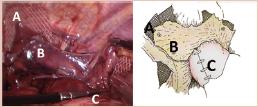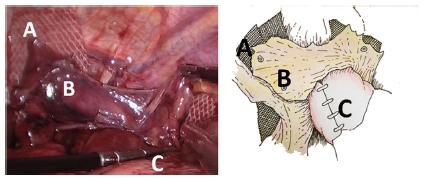ABSTRACT
Background:
Erosion and migration into the esophagogastric lumen after laparoscopic hiatal hernia repair with mesh placement has been published.
Aim:
To present surgical maneuvers that seek to diminish the risk of this complication.
Method:
We suggest mobilizing the hernia sac from the mediastinum and taking it down to the abdominal position with its blood supply intact in order to rotate it behind and around the abdominal esophagus. The purpose is to cover the on-lay mesh placed in “U” fashion to reinforce the crus suture.
Results:
We have performed laparoscopic hiatal hernia repair in 173 patients (total group). Early postoperative complications were observed in 35 patients (27.1%) and one patient died (0.7%) due to a massive lung thromboembolism. One hundred twenty-nine patients were followed-up for a mean of 41+28months. Mesh placement was performed in 79 of these patients. The remnant sac was rotated behind the esophagus in order to cover the mesh surface. In this group, late complications were observed in five patients (2.9%). We have not observed mesh erosion or migration to the esophagogastric lumen.
Conclusion:
The proposed technique should be useful for preventing erosion and migration into the esophagus.
HEADINGS:
Hiatal hernia, repair; Mesh erosion, prevention

 Both fixed branches of mesh were completely covered with the rotated preserved sac: A) fixed mesh; B) preserved sac covering the mesh; C) fundoplication
Both fixed branches of mesh were completely covered with the rotated preserved sac: A) fixed mesh; B) preserved sac covering the mesh; C) fundoplication

 A=remnant sac rotation passing behind the esophagus; B=mesh; C=esophagus; D=right crus dissection above the preserved hepatic branches of the anterior vagus nerve.
A=remnant sac rotation passing behind the esophagus; B=mesh; C=esophagus; D=right crus dissection above the preserved hepatic branches of the anterior vagus nerve.
